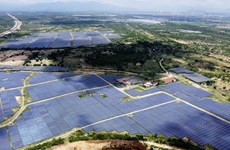Mekong Delta is getting a real sinking feeling
Sinking land in the Mekong Delta is causing a headache for the local administration.
 People struggle to drive in a section of Ben Phu Dinh street, flooded by tides in HCM City early October (Photo: VNA)
People struggle to drive in a section of Ben Phu Dinh street, flooded by tides in HCM City early October (Photo: VNA)HCM City (VNS/VNA) - Sinking land in the Mekong Delta is causing a
headache for the local administration.
In recent years, average land subsidence rate is 1.1cm every 12 months.
This can lead to major economic losses such as structural damage and high maintenance costs for roads, railways, dikes, pipelines and buildings.
The situation is more serious in cities and industrial parks with the subsidence rate of 2.5cm per year. In HCM City, the land subsidence already reached up to 7.3cm per year.
Underground water overexploitation, sea level rise as well as substandard drainage system are blamed for the situation, the Thanh Nien (Young People) online newspaper reported.
Data from the provinces of Soc Trang and Bac Lieu showed that about 100,000cu.m of underground water were exploited every day in Soc Trang and the number was 400,000cu.m daily in Bac Lieu province.
The two provinces, which have a range of industrial parks, were among the localities that suffered the most in the delta.
Research by the Utrecht University released by the Hanoi-based Netherlands Embassy in June 2017, said the speed of the land subsidence caused by the overexploitation of underground water continuously rose over the past of 25 years.
In the meantime, the sea level rise was only 3mm per year. It meant the speed of 1.1cm per year was also higher than the speed of sea level rise, the research said.
The report described the situation as ‘very alarming’.
In HCM City, the land subsidence also has spread in many districts in recent years.
A study conducted by Associate Professor Le Van Trung and his colleagues at HCM City University of Technology pointed out that the land subsidence was only discovered in some areas of Binh Thanh district and District 6 in 1998. A few years later, it was found in a range of districts of 7,8,9,11,12, Tan Phu, Binh Tan, Binh Thanh, Go Vap, Hoc Mon, Binh Chanh and Nha Be.
Trung said this combined with the sea level rise would more severely threaten daily life of local residents if the city administration failed to plan for water drainage and flood prevention.
In an attempt to curb the water overexploitation, the Ministry of Natural Resources and Environment has compiled a draft decree to tighten control.
The ministry will not allow new construction to exploit underground water. It will also review and make adjustments for current works.
Additionally, experts suggest the local administration of the delta’s provinces should calculate the base level of foundation for construction works.
It aimed to minimise impacts of flooding on the local residents’ daily life.
|Architect Le Cong Sy said the adjustment of the base level of foundation for construction work should be carefully calculated based on current and future data.
Currently, the base level of foundation for construction work nation-wide is regulated to be two metres higher than the sea level, he said.
However, with the current speed of land subsidence and sea level rise, some localities, especially, HCM City was advised to adjust the base level of foundation for construction work to prevent flood, he said.
In a related move, the Southern Institute for Spatial Planning under the Ministry of Construction wants to raise the base level of foundation for construction work to 2.5-3.2m by 2030.
Improvement of drainage system was thought to be one of methods to cope with floods, experts said.
Nguyen Hoai Nam, former deputy director of HCM City’s Department of Planning and Investment said the authorised agencies were asked to learn from the Netherlands’ model.
The Mekong Delta is home to nearly 18 million people, and is the most important rice and fishing region in the country. HCM City is the largest city in Vietnam, with a population of more than 8 million.-VNS/VNA
In recent years, average land subsidence rate is 1.1cm every 12 months.
This can lead to major economic losses such as structural damage and high maintenance costs for roads, railways, dikes, pipelines and buildings.
The situation is more serious in cities and industrial parks with the subsidence rate of 2.5cm per year. In HCM City, the land subsidence already reached up to 7.3cm per year.
Underground water overexploitation, sea level rise as well as substandard drainage system are blamed for the situation, the Thanh Nien (Young People) online newspaper reported.
Data from the provinces of Soc Trang and Bac Lieu showed that about 100,000cu.m of underground water were exploited every day in Soc Trang and the number was 400,000cu.m daily in Bac Lieu province.
The two provinces, which have a range of industrial parks, were among the localities that suffered the most in the delta.
Research by the Utrecht University released by the Hanoi-based Netherlands Embassy in June 2017, said the speed of the land subsidence caused by the overexploitation of underground water continuously rose over the past of 25 years.
In the meantime, the sea level rise was only 3mm per year. It meant the speed of 1.1cm per year was also higher than the speed of sea level rise, the research said.
The report described the situation as ‘very alarming’.
In HCM City, the land subsidence also has spread in many districts in recent years.
A study conducted by Associate Professor Le Van Trung and his colleagues at HCM City University of Technology pointed out that the land subsidence was only discovered in some areas of Binh Thanh district and District 6 in 1998. A few years later, it was found in a range of districts of 7,8,9,11,12, Tan Phu, Binh Tan, Binh Thanh, Go Vap, Hoc Mon, Binh Chanh and Nha Be.
Trung said this combined with the sea level rise would more severely threaten daily life of local residents if the city administration failed to plan for water drainage and flood prevention.
In an attempt to curb the water overexploitation, the Ministry of Natural Resources and Environment has compiled a draft decree to tighten control.
The ministry will not allow new construction to exploit underground water. It will also review and make adjustments for current works.
Additionally, experts suggest the local administration of the delta’s provinces should calculate the base level of foundation for construction works.
It aimed to minimise impacts of flooding on the local residents’ daily life.
|Architect Le Cong Sy said the adjustment of the base level of foundation for construction work should be carefully calculated based on current and future data.
Currently, the base level of foundation for construction work nation-wide is regulated to be two metres higher than the sea level, he said.
However, with the current speed of land subsidence and sea level rise, some localities, especially, HCM City was advised to adjust the base level of foundation for construction work to prevent flood, he said.
In a related move, the Southern Institute for Spatial Planning under the Ministry of Construction wants to raise the base level of foundation for construction work to 2.5-3.2m by 2030.
Improvement of drainage system was thought to be one of methods to cope with floods, experts said.
Nguyen Hoai Nam, former deputy director of HCM City’s Department of Planning and Investment said the authorised agencies were asked to learn from the Netherlands’ model.
The Mekong Delta is home to nearly 18 million people, and is the most important rice and fishing region in the country. HCM City is the largest city in Vietnam, with a population of more than 8 million.-VNS/VNA













